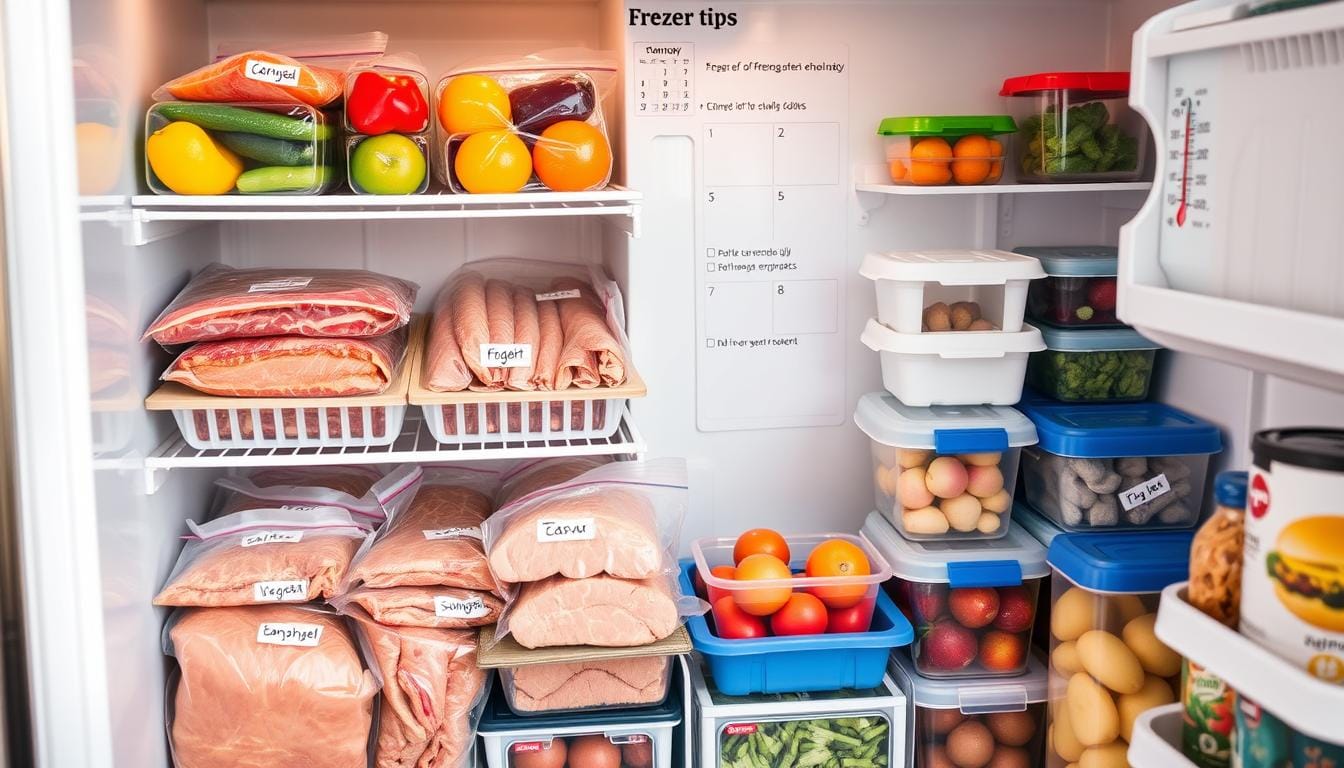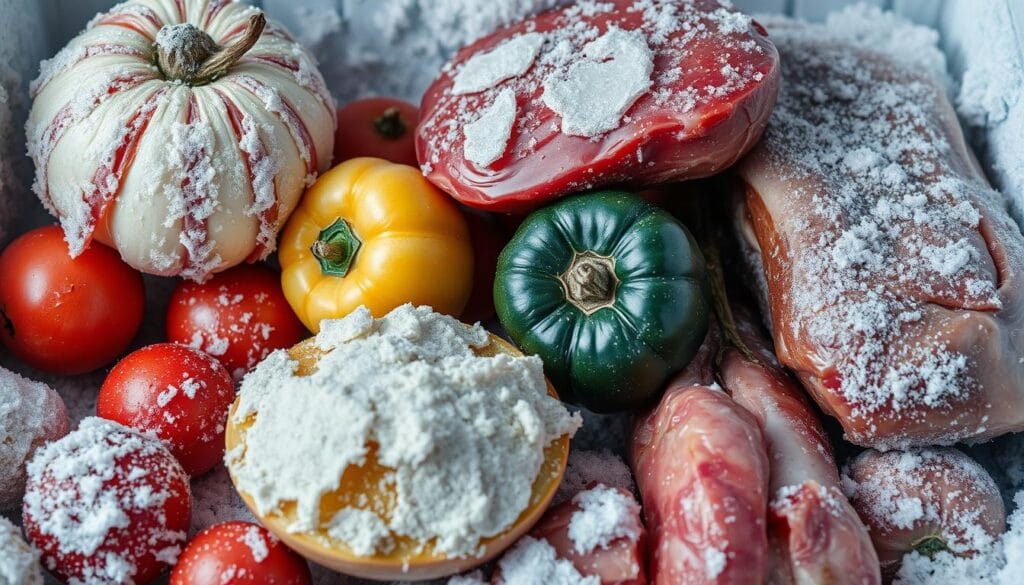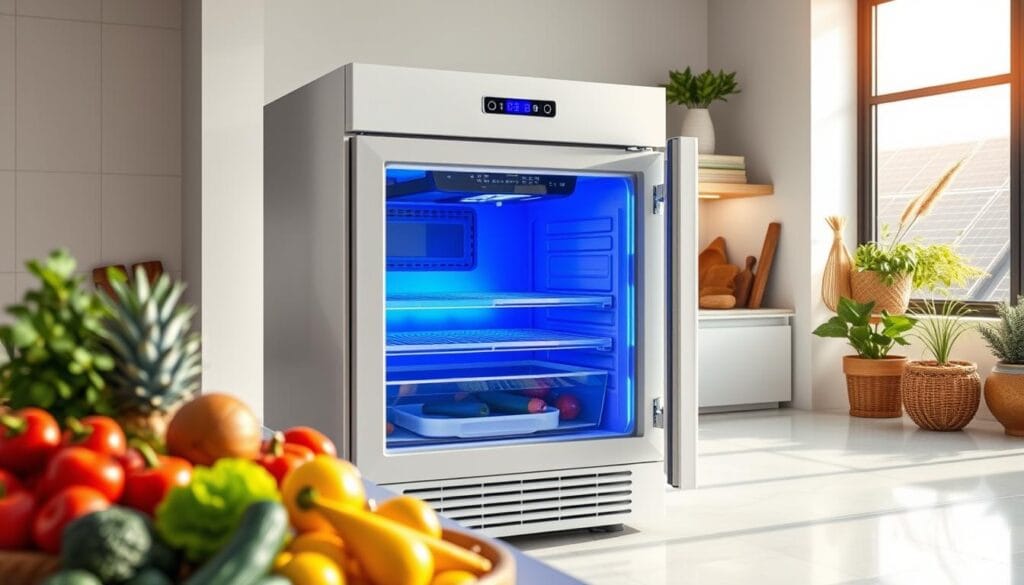Imagine a world where your favorite meals and snacks never spoil. Every bite is as fresh as the day you first made it. Proper freezer management can make this dream come true. It turns your kitchen into a place of endless possibilities. You need our best freezer tips!
As a busy parent, I’ve seen how freezers are lifesavers. They let me plan meals ahead, cut down on waste, and enjoy my favorite flavors without worrying about when they’ll go bad.
In this guide, we’ll cover the top freezer tips. You’ll learn how to organize your freezer and freeze and thaw food like a pro. These tips are for everyone, whether you’re an experienced cook or just starting with meal prep. They’ll help you use your freezer space better and keep your kitchen stocked with delicious food.
Understanding Freezer Storage Basics
Using your freezer right is key to keeping your food fresh and safe. Knowing the basics of freezer storage is important for this.
Importance of Proper Freezer Use
The Food Standards Agency says it’s vital to keep your freezer at -18°C (-0.4°F). This ensures your food freezes well and stays good for a long time. It’s also good to chill foods in the fridge first. This helps stop ice crystals from forming, which can hurt the quality of your food.
It’s smart to use a fridge/freezer thermometer. This helps you keep an eye on the temperature. Putting warm foods straight into the freezer can make the temperature rise. This might not be safe for your food. Keeping your freezer organized and clean, like defrosting regularly, also helps it work better.
Optimal Freezer Temperature Settings
- * Frozen food compartment runs at -6°C (21.2°F) and should only store food for up to one week
- Frozen food compartment runs at -12°C (10.4°F) and should only store food for up to one month
- Frozen food compartment runs at -18°C (-0.4°F) and should only store food for up to three months
- Freezer runs at -18°C (-0.4°F) and is suitable for long-term storage (three months or longer)
Keeping your freezer at the right temperature is crucial. It helps your frozen foods last longer and stay nutritious.
“Proper freezer use is essential for food safety and quality. The Food Standards Agency recommends keeping freezers at -18°C for thorough freezing.”
Choosing the Right Containers
Choosing the right containers is key to keeping your food fresh in the freezer. They help save space and prevent freezer burn. The type of container you pick greatly affects your food’s quality and how long it lasts.
Best Types of Freezer Containers
Go for square or rectangular containers to use your freezer space wisely. These shapes let you stack them well, saving space. For liquids like soups, use shallow containers to let them expand when they freeze.
- Rigid plastic or glass containers with tight-fitting lids are great for both dry and liquid foods.
- Gusseted freezer bags that stand upright when full are perfect for small portions.
- Reusable silicone or BPA-free plastic bags are better for the environment than single-use ones.
How to Label Your Freezer Items
It’s important to label your freezer items clearly. Use a freezer-safe marker or label maker to mark what’s inside and when you froze it. This makes it easy to find what you need and ensures you eat it before it goes bad.
| Product | Price | Capacity |
|---|---|---|
| Rubbermaid Brilliance Food Storage Containers | $30 – $45 | 3.2 cups per container |
| Deli Storage Containers Set | $23 – $46 | 1, 2, or 4 cups per container |
| OXO Containers for Stews and Casseroles | $15 | 4 cups per container |
| Heavy-Duty Glass Containers | $38 – $60 | Set of four different-sized containers |
By picking the right freezer containers and labeling your freezer items well, you keep your food fresh and easy to find. This makes your freezer organization system work better.
Preparing Food for Freezing
Freezing food can change how you manage your food and cut down on waste. It helps keep fresh flavors in fruits and veggies, stores meat safely, and saves leftovers. There are key steps to follow.
Best Practices for Freezing Fruits and Vegetables
Freezing produce can be easy. Puree items like berries or leafy greens before freezing. This saves space and makes them easy to use in smoothies or sauces.
Good choices for frozen veggies include Brussels sprouts, peas, riced cauliflower, and spinach. They freeze well. Frozen fruits are great for oatmeal, smoothies, and baked goods.
Safe Meat Freezing Techniques
Storing meat safely is crucial. Cool cooked meats down before freezing. Use airtight containers or freezer bags to avoid freezer burn.
When cooking in batches, portion leftovers with rice or grains. This makes reheating easy.
Freezing Leftovers Effectively
Freezing leftovers is a smart move to reduce waste. But, avoid freezing yogurt, watery produce, uncooked mushrooms, and raw potatoes. They can get mushy or lose texture.
However, stir-fries, curries, soups, casseroles, and cooked rice freeze well. They’re perfect for quick, ready-to-eat meals.
Using these freezing techniques can make your food prep easier. Enjoy the perks of batch cooking for months.
“Freezing is a great way to preserve the freshness and flavor of your favorite foods, making meal planning and preparation a breeze.”
Organizing Your Freezer: freezer tips
Keeping your freezer organized is crucial for extending food storage life. It helps you use your frozen items efficiently. By using smart freezer organization methods, you can easily find what you need, cut down on waste, and make meal planning easier.
Tips for Efficient Freezer Layout
Begin by sorting similar foods together on your freezer shelves or in bins. This makes finding ingredients simpler. Label each shelf or bin clearly, like “Meat,” “Vegetables,” or “Baked Goods,” for a clear system.
Organize items by their expiration dates, placing the soonest ones front and center. This way, you use older items first, cutting down on waste. Resetting your freezer once a year also keeps it organized.
Keeping Track of Your Frozen Inventory
Make a detailed list of your freezer’s contents. Update it often, noting what you have, how much, and when you stored it. This stops you from forgetting items or buying duplicates.
Use freezer-friendly containers and a vacuum sealer to save space and keep food quality high. Labeling containers with what’s inside and when you stored it makes things even easier.
By following these tips, you’ll manage your freezer better, reduce waste, and make meal prep simpler. A tidy freezer saves you time and money. It also means you always have what you need for tasty, homemade meals.
Thawing Foods Safely
Proper thawing is key for food safety and quality. Frozen meats, fish, or dishes need to thaw before cooking or reheating. The best way is to thaw them in the fridge, slowly reaching the right temperature.
Recommended Thawing Methods
- Refrigerator Thawing: This is the top choice for thawing frozen foods. It takes about 24 hours to thaw 5 pounds in the fridge.
- Cold Water Thawing: Put the frozen item in cold water, changing it every 30 minutes to keep it under 41°F. It’s quicker than fridge thawing but needs constant watch.
- Microwave Thawing: Use the microwave for small items to thaw fast. But be careful not to cook the food partially.
Common Mistakes to Avoid When Thawing
Don’t thaw food at room temperature or in hot water. Bacteria grow fast in the “danger zone” of 41°F to 135°F. This can ruin the food’s quality and safety. Avoid thawing on the counter or in hot water to prevent harmful bacteria growth.
Stick to the safe thawing methods and avoid mistakes. This way, your frozen foods will thaw safely and stay good for you to enjoy.
Understanding Freezing Time Limits
Storing food properly is key to keeping it fresh and safe. But, all frozen foods have a limited time they can stay good. Knowing how long to freeze different foods helps you use your freezer wisely and avoid spoilage.
How Long Can You Freeze Different Foods?
Different foods have different freezer lifespans. Here’s a basic guide:
- Meat and poultry: 3 to 6 months
- Fish: 2 to 6 months, depending on the type
- Bread and baked goods: 2 to 3 months
- Fruits and vegetables: 8 to 12 months, with proper preparation
- Butter and margarine: 6 to 12 months
Keep in mind, these times are just estimates. The actual shelf life can change based on your freezer’s quality, how you package the food, and the food itself. Foods in a standalone freezer usually last longer than those in a fridge’s freezer.
Signs of Freezer Burn and Spoilage
Even well-stored frozen foods can lose quality over time. A common sign is freezer burn – dry, grayish or brown spots on the food’s surface. These spots are from dehydration and oxidation. Though safe to eat, freezer-burned foods might taste or feel off.
Other signs of spoilage include:
- Discoloration or changes in color
- Off-smells or unpleasant odors
- Visible ice crystals or excessive liquid upon thawing
- Slimy or sticky texture
If you see these signs, it’s best to throw out the food. This prevents health risks and bad dining experiences.
“Rapid freezing improves food quality by forming smaller ice crystals, reducing damage to cell walls. Slow freezing creates large ice crystals that puncture cell membranes, leading to more dripping and liquid loss upon thawing.”
Maintaining Your Freezer
Keeping your freezer in good shape is key to its efficiency and the freshness of your food. Regular cleaning and smart organization are essential. These steps help save energy and keep your food fresh longer.
Importance of Regular Freeze Maintenance
A household freezer usually lasts about 13 years, says Gifam. But with the right care, it can last even longer. Cleaning, defrosting, and checking the seals are simple ways to keep it running well. These actions help avoid expensive fixes or early replacements.
Tips for Efficient Freezer Usage
- Keep your freezer full but not too packed. A full freezer stays colder, saving energy.
- Make sure there’s room for air to circulate. This keeps the temperature right.
- Use special spots for big items or meal prep. This keeps things organized and avoids mess.
- Label everything with what’s inside and when it was put in. This helps you use things correctly.
- Check the seals around the freezer door often. A tight seal helps the compressor work less hard.
By following these freezer maintenance tips, you can make your appliance last longer. You’ll also save energy and keep your food fresh.
“For meat, it is recommended to wrap each piece individually in plastic wrap before placing in the freezer to prevent clumping.”
Energy Efficiency Tips for Your Freezer
Keeping your freezer energy-efficient can save a lot on your bills. Simple tips can make your freezer use less energy. This helps cut down on your energy use.
How to Reduce Freezer Energy Consumption
One key way to save energy is to keep your freezer full but not too full. A full freezer keeps the temperature steady. This stops warm air from getting in and makes the freezer work less hard.
Also, defrosting your freezer regularly helps it work better. This is especially true for manual-defrost freezers.
Getting an energy-efficient freezer is another smart move. Look for ones with the ENERGY STAR label. These use much less energy than regular models.
Best Practices for Freezer Placement
- Put your freezer in a cool, dry spot, away from sunlight or heat.
- Make sure there’s enough space around the freezer for air to move.
- Don’t put the freezer in a warm, humid place. It won’t work as well and will use more energy.
By following these tips, you can enjoy your freezer without breaking the bank. Small changes can make a big difference in your energy bills and the planet.
| Energy Efficiency Tip | Potential Energy Savings |
|---|---|
| Keeping the freezer full but not overcrowded | Up to 15% energy savings |
| Upgrading to an ENERGY STAR certified freezer | Up to 25% energy savings |
| Placing the freezer in a cool, dry location | Up to 10% energy savings |
| Regularly defrosting manual-defrost freezers | Up to 20% energy savings |
“Proper placement and maintenance of your freezer can significantly reduce your energy costs and environmental impact.”
When to Consider Upgrading Your Freezer
As your freezer gets older, watch for signs it might need a new one. Look out for inconsistent temperatures, high energy use, and not enough space. A newer, energy-saving model from brands like KitchenAid can improve how you store and prepare food.
Signs That Your Freezer May Need Replacement
If your freezer can’t keep a steady temperature, needs constant repairs, or uses a lot of energy, it’s time to think about a new one. Older freezers often lack the latest tech and energy-saving features. This can make them less efficient and more expensive to run.
Benefits of Modern Freezer Technology
Getting a newer, energy-efficient freezer brings many benefits. You’ll get better temperature control, more storage space, and cool features like remote monitoring. Look for Energy Star certified models to save on energy costs. Also, find ones with customizable temperature settings to fit your needs.
FAQ
What are the key benefits of proper freezer use?
Using your freezer right can save you money and time. It helps reduce food waste and lets you prep meals ahead. Plus, you’ll always have fresh ingredients on hand.
What is the recommended freezer temperature setting?
The Food Standards Agency says keep your freezer at -18°C (0°F). This ensures your food is frozen well and stays safe to eat.
What are the best types of containers for freezing food?
Choose square or rectangular containers for best space use. Use shallow ones for liquids. Gusseted freezer bags are great because they stand up when full.
How should I prepare food for freezing?
Cool food down completely before freezing. Puree fruits and veggies with high water content to save space. Freeze items like lemon, stock, and herbs in ice cube trays.
How can I organize my freezer effectively?
Organize by food type and label shelves or drawers. Keep a detailed list of what’s inside. This helps avoid buying duplicates and forgetting what you have.
What is the safest way to thaw frozen foods?
Thaw meat, fish, and dishes in the fridge overnight. This ensures they thaw completely and avoids exposure to room temperature.
How long can different foods be stored in the freezer?
Meat and fish last 3-6 months. Bread stays good for 2-3 months. After these times, food is still safe but might not taste as good.
How can I maintain my freezer’s efficiency?
Keep your freezer full but not too packed. Make sure air can circulate. Defrost manual models regularly to keep them running well.
How can I reduce my freezer’s energy consumption?
Place your freezer in a cool, dry spot. Keep it full but not too tight. If your freezer is old, think about getting a new, energy-saving one.
When should I consider upgrading my freezer?
Upgrade if your freezer is not working well. Look for signs like uneven temperatures or high energy use. New freezers are more efficient, organized, and have cool features.



